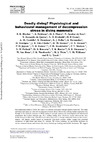Identificador persistente para citar o vincular este elemento:
https://accedacris.ulpgc.es/jspui/handle/10553/47518
| Título: | Deadly diving? Physiological and behavioural management of decompression stress in diving mammals | Autores/as: | Hooker, Sascha K. Fahlman, Andreas Moore, Michael John Aguilar de Soto, Natacha Bernaldo De Quirós Miranda, Yara Brubakk, Alf Ottar Costa, Daniel P. Costidis, Alexander M. Dennison, Sophie E. Falke, Konrad J. Fernández Rodríguez, Antonio Jesús Ferrigno, Massimo Fitz-Clarke, John R. Garner, Michael M. Houser, Dorian S. Jepson, Paul D. Ketten, Darlene R. Kvadsheim, Petter Helgevold Madsen, Peter Teglberg T. Pollock, Neal W. Rotstein, David S. Rowles, Teresa K. Simmons, Samantha E. van Bonn, William G. Weathersby, Paul K. Weise, Michael J. Williams, Terrie M. Tyack, Peter L. |
Clasificación UNESCO: | 240111 Patología animal 310907 Patología |
Palabras clave: | Dolphins Tursiops-Truncatus Gas-Bubble Lesions Foraging Behavior Beaked-Whales Heart-Rates, et al. |
Fecha de publicación: | 2012 | Editor/a: | 0962-8452 | Publicación seriada: | Proceedings of the Royal Society B: Biological Sciences | Resumen: | Decompression sickness (DCS; 'the bends') is a disease associated with gas uptake at pressure. The basic pathology and cause are relatively well known to human divers. Breath-hold diving marine mammals were thought to be relatively immune to DCS owing to multiple anatomical, physiological and behavioural adaptations that reduce nitrogen gas (N-2) loading during dives. However, recent observations have shown that gas bubbles may form and tissue injury may occur in marine mammals under certain circumstances. Gas kinetic models based on measured time-depth profiles further suggest the potential occurrence of high blood and tissue N-2 tensions. We review evidence for gas-bubble incidence in marine mammal tissues and discuss the theory behind gas loading and bubble formation. We suggest that diving mammals vary their physiological responses according to multiple stressors, and that the perspective on marine mammal diving physiology should change from simply minimizing N-2 loading to management of the N-2 load. This suggests several avenues for further study, ranging from the effects of gas bubbles at molecular, cellular and organ function levels, to comparative studies relating the presence/absence of gas bubbles to diving behaviour. Technological advances in imaging and remote instrumentation are likely to advance this field in coming years. | URI: | https://accedacris.ulpgc.es/handle/10553/47518 | ISSN: | 0962-8452 | DOI: | 10.1098/rspb.2011.2088 | Fuente: | Proceedings of The Royal Society B-Biological Sciences [ISSN 0962-8452], v. 279 (1731), p. 1041-1050 |
| Colección: | Reseña |
Citas SCOPUSTM
101
actualizado el 08-jun-2025
Citas de WEB OF SCIENCETM
Citations
92
actualizado el 08-jun-2025
Visitas
101
actualizado el 17-may-2025
Descargas
105
actualizado el 17-may-2025
Google ScholarTM
Verifica
Altmetric
Comparte
Exporta metadatos
Los elementos en ULPGC accedaCRIS están protegidos por derechos de autor con todos los derechos reservados, a menos que se indique lo contrario.
